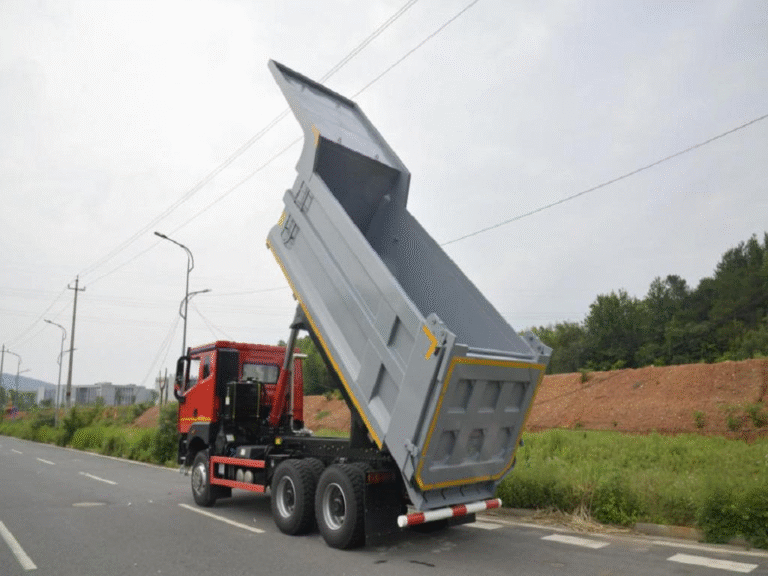Payload capacity is a crucial factor when it comes to the efficient and safe operation of dump trucks. It determines how much material a truck can safely carry without risking damage or reducing performance. Operators must carefully consider payload limits to ensure optimal efficiency and avoid potential hazards. By understanding the importance of payload capacity, one can make informed decisions that benefit both safety and cost-efficiency.
Understanding Payload Capacity in Dump Trucks
What Payload Capacity Means
Payload capacity refers to the maximum weight a dump truck can safely carry, including both cargo and passengers. This capacity is dictated by the strength of the truck’s structure and its mechanical components. Exceeding this limit can result in mechanical failures or accidents. Consistently operating within the recommended payload ensures that the truck functions effectively and prolongs its operational life, preventing unnecessary wear and tear.
Key Factors That Determine Payload
Several factors influence a dump truck’s payload capacity. These include the truck’s overall size, the strength of the chassis, the design of the suspension system, and the power of the engine. Additionally, manufacturers set specific limits based on rigorous testing. Understanding these elements helps operators choose the right truck for their needs, balancing performance and capacity without compromising safety.
Common Misconceptions About Payload Limits
Many operators misunderstand payload limits, believing that a truck can handle more than its specified capacity if handled carefully. However, this misconception can lead to frequent overloading, increasing the risk of accidents and vehicle breakdowns. Another misconception is that payload limits include only the cargo, ignoring additional weight factors like passengers and equipment. It’s essential to adhere strictly to manufacturer guidelines for safe operation.
Why Payload Capacity Matters for Safety and Efficiency
Overloading Risks and Safety Concerns
Overloading a dump truck poses significant safety risks, such as diminishing braking capacity and compromising vehicle stability. An overloaded truck is harder to control and more susceptible to tipping over, particularly during sharp turns or sudden stops. Safety should always be a top priority, and maintaining proper payload limits is critical to ensuring the safety of both the operators and other road users.
Impact on Fuel Consumption and Maintenance
Carrying loads within the recommended payload capacity ensures optimal fuel efficiency. Overloading causes the engine to work harder, increasing fuel consumption and leading to higher operational costs. Additionally, exceeding payload limits accelerates wear on critical components, resulting in frequent maintenance needs and reducing the truck’s lifespan. Properly managing payload reduces these unnecessary expenses.
Effects on Truck Longevity and Performance
Properly adhering to payload limits directly affects the longevity and performance of dump trucks. Consistent overloading can lead to premature aging of the vehicle, requiring extensive repairs and parts replacements. By managing loads within the advised capacities, trucks can remain operational for longer durations without compromising performance. This approach enhances productivity and extends vehicle lifespan, providing better value over time.
Calculating and Managing Payload Capacity
How to Calculate Safe Payload
To calculate a truck’s payload capacity, subtract its curb weight (the weight of the empty truck) from its Gross Vehicle Weight Rating (GVWR), which is provided by the manufacturer. This difference gives the maximum payload the truck can carry safely. Operators should regularly check truck weights and ensure they account for variables like fuel and accessories to maintain safety margins.

Best Practices to Manage Load Distribution
Effective load distribution is crucial to maintaining balance and stability. Operators should load the heaviest items first, placing them towards the center to minimize strain on the axles. Even distribution helps maintain control, especially during turns and braking. Regular training on loading techniques can greatly enhance the safety and efficiency of hauling operations.
Tools and Technology That Assist Operators
Various modern tools and technologies assist operators in managing payload capacities. On-board scales provide real-time weight monitoring, helping prevent overloading. GPS and telematics systems offer insights into vehicle performance and load distribution. By employing these technologies, operators can ensure they maintain optimal loads, improve safety measures, and enhance overall operational efficiency.
Cost Implications of Proper Payload Management
Reducing Operating Costs with Correct Payload
Adhering to correct payload limits reduces overall operating costs by minimizing fuel consumption and decreasing the frequency of maintenance. Correctly loaded trucks operate more efficiently, traveling longer distances without the need for excessive refueling. Operators can reduce expenses significantly by keeping trucks within their designed operational parameters.
Avoiding Legal Penalties and Downtime
Operating a dump truck beyond its payload capacity can result in legal consequences, including fines and downtime due to required inspections and repairs. Compliance with load regulations minimizes these risks, ensuring the fleet remains operational and financially viable. Legal adherence also helps maintain a solid reputation within the industry, avoiding complications with regulatory bodies.
Boosting Profitability Through Efficient Hauling
Proper payload management boosts profitability by optimizing each trip’s efficiency. By maximizing each haul without exceeding safe limits, operators can reduce the number of trips required for a job. This efficiency not only saves on fuel and labor costs but also enables faster project completion. Enhanced operational efficiency directly contributes to increased profitability and client satisfaction.
Conclusion
Recognizing the importance of payload capacity in dump trucks is essential for safety, efficiency, and profitability. Proper understanding and management of payload limits help prevent overloading, reduce maintenance costs, and increase the lifespan of equipment. By adopting best practices and utilizing technology, operators can enhance performance and achieve better outcomes. Prioritizing correct payload management ultimately supports a safer and more productive operation.


